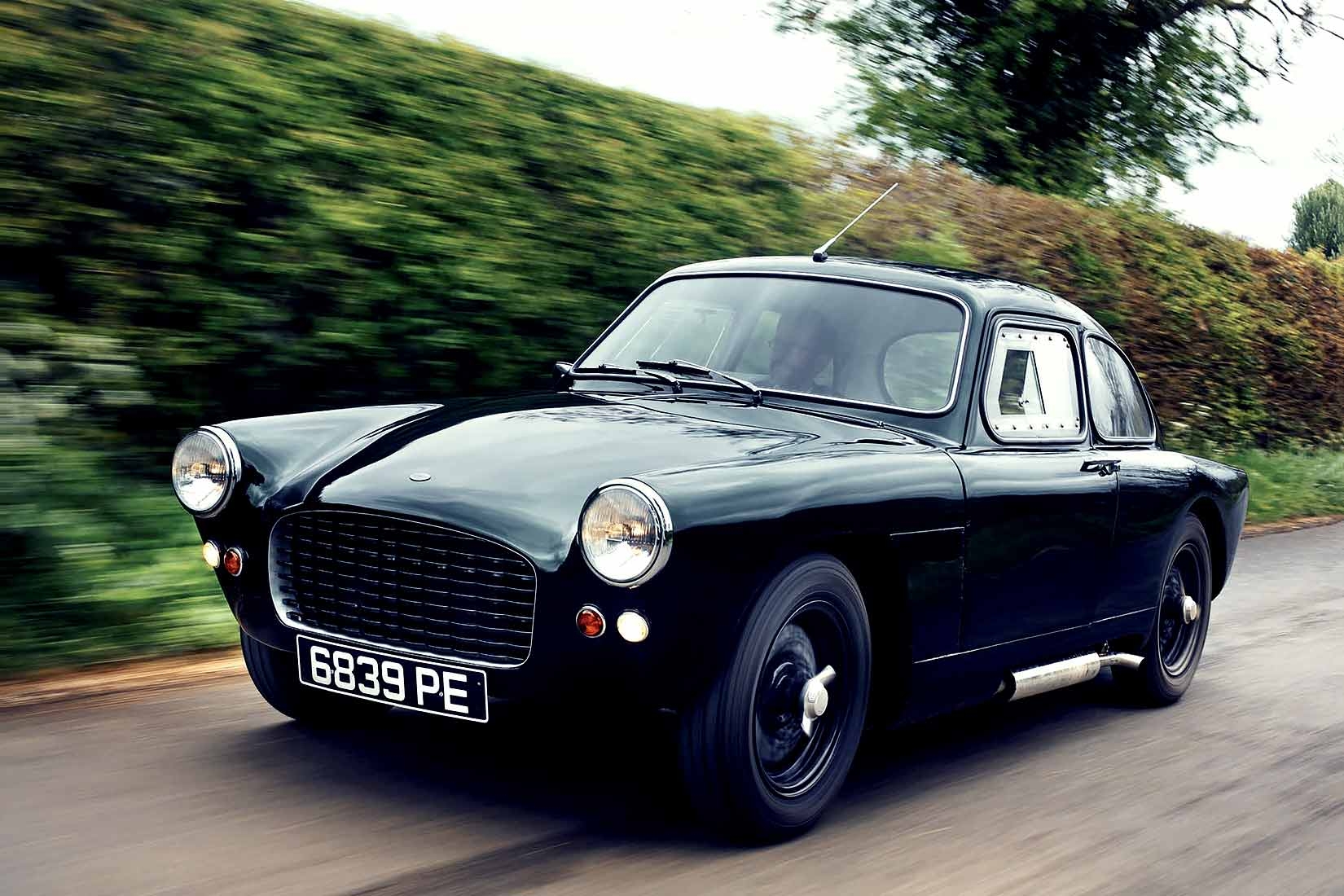
One for the road Tojeiro-Climax. The one-off coupé that’s a baby Aceca Most Tojeiros were destined for a life in competition, says Malcolm Thorne, but this jewel-like Climax-powered GT was designed for a different role. Photography James Mann / Archive LAT/ Gilbern Owners’ Club.
We drive the fantastic Tojeiro-Climax, a unique race-bred GT.
What a golden age the late 1950s was for fans of sporting machinery. After the privations and post-war rationing – not to mention the awful pool petrol – the decade opened up all sorts of exciting opportunties. Besides the mainstream MGs, Triumphs and Healeys, there were lots of options for those seeking something individual.
From the bones of a ropey old Austin Seven or Ford Eight, a delightful little roadster could be cobbled together for a few quid. For those with deeper pockets, meanwhile, a cottage industry of up-and-coming équipes was happy to produce a more sophisticated bolide. The complexity and cost of developing a car today – not to mention the difficulty of meeting the regulations – means that anything half-decent is unlikely to emerge from a lock-up. But six decades ago, it seems, the most important items were a fertile mind and a bit of bravado. With a healthy dose of ingenuity, a few talented blokes in a railway arch could knock together a credible sports car. It was an exciting time, peppered with names that would enter into motoring folklore: Lotus and Cooper, Costin and Lola, plus plenty more. Those backstreet racers could give the big boys a run for their money. And it was in such a context that the fixed-head you see here first saw the light of day.
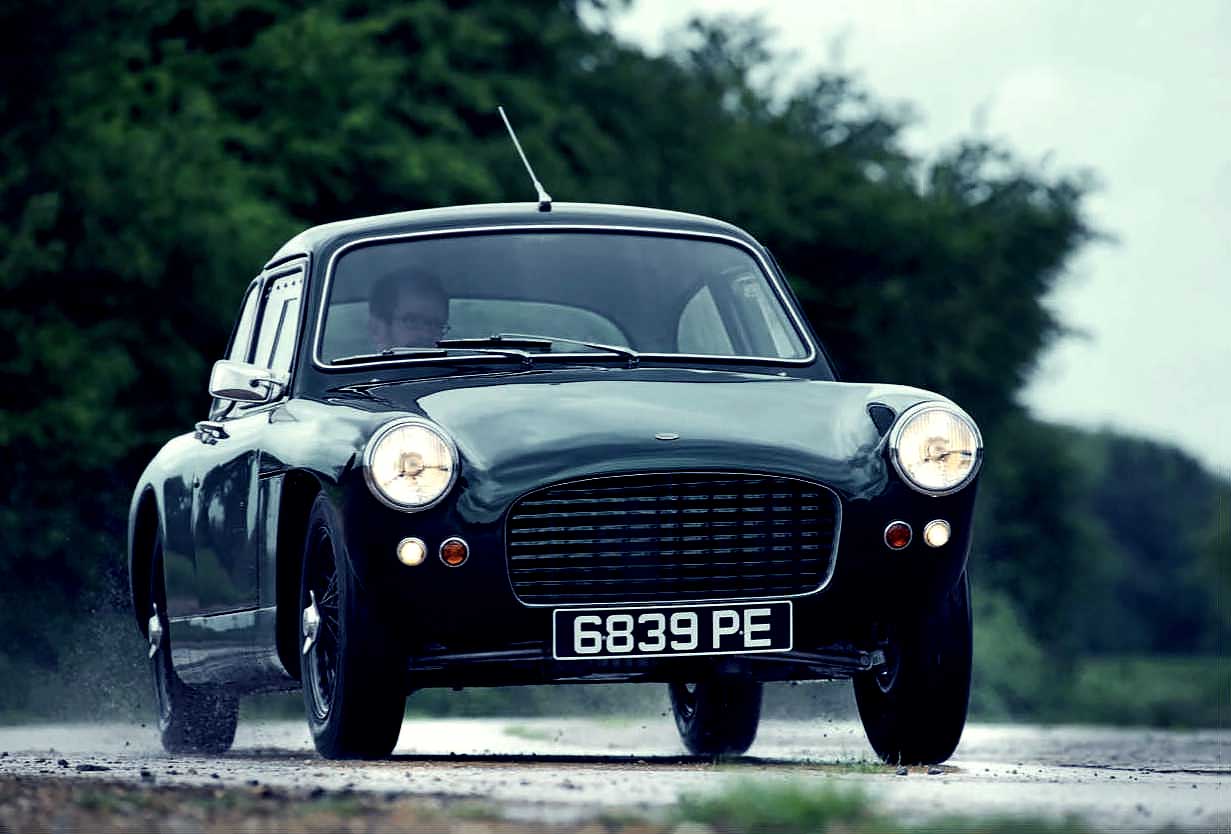
1958 Tojeiro Climax Coupe road test
Commissioned by one Frank BP Rambridge of West Clandon, near Guildford in Surrey, the Tojeiro-Climax is the quintessential bespoke coupé for a flat-capped, jacketed chap, probably sporting a ’tache. Skinned with a streamlined aluminium body by Wakefield and Sons of West Byfleet, below the surface lay a state-of-the-art competition chassis engineered and built by the grandly named Tojeiro Automotive Developments – which was, in fact, a two-man operation working from a shed. Be that as it may, this was a thoroughly engineered vehicle that, in its ironmongery, was leagues ahead of such mass-market products as the fixed-head MGA with its pushrod boat anchor and leaf-sprung live axle.
Built and fettled by Competition Motors of Weybridge, the car was first registered 1 GPF in August 1958 after a two-year gestation. Badged simply as a Tojeiro – a moniker that today, sadly, is as likely to furrow brows as elicit nods of recognition – it was pressed into service as its owner’s regular transport, soon racking up some 20,000 miles. During Bambridge’s time with the coupé, his wife Mary had complained that the steering was excessively heavy when parking, and so the front end was eventually dismantled and modified components were ordered.
Sadly, the original parts were scrapped and the replacements proved to be of incorrect size, so the work stalled when other commitments took over. The car remained immobile until May ’1967, at which point an imminent move prompted Bambridge to part with it. Re-registered 6839 PE, the non-runner was taken in part-exchange (along with a van and a boat) against a new Mini Cooper ‘S’ by dealer Paul Vasey of Dorking on 12 June. Bambridge commented unsentimentally that he ‘should be very pleased to be relieved of what takes up so much garage space’.
Vasey retained the Tojeiro for 12 months, before he sold it to a Jonathan Carr Selway of Luton in June 1968, but by October it was with one Robin David Elliot Legg of Lincolnshire. Six months later, Geoff Henderson, then a student at Newcastle University, purchased the car – which he described as being immaculate – for a princely £110. The MGA racer competed with it at a Croft MG Car Club event.
‘The engine was always smooth and willing to rev and the handling good,’ he reported. ‘I used 7500rpm in the lower gears, and the car would reach an indicated 120mph at 7000rpm.’ Despite being full of praise for the baby GT, though, he sold it to his brother Martyn a few months later.
Unfortunately, an illicit race from the pub to a local chippy in 1970 resulted in a damaged bonnet after coming to blows with a hapless cow. The car was repaired and painted white, then used by Martyn for travelling between the north-east and Hounslow, where he was working at the time. It changed hands again in November 1971, going to Jim Muncaster of Stanley in County Durham.
He rarely used the car, which was eventually laid up. After Muncaster passed away, the Tojeiro was acquired by its current owner, Peter Barguss, in ’2009. “It was complete but in need of considerable work after a long period of inactivity,” recalls Barguss, who entrusted it to Beacon Hill Garage for a meticulous rebuild, including a respray in the original metallic racing green with black wires. It’s a remarkably petite device that is gawkily seductive in the same way as so many of its British sporting contemporaries. The styling melds flourishes from a dozen different makes and models – AC Aceca, Peerless and Gilbern GT, to name but a few – in a way that is both weird and wonderful. It may come as a surprise, then, that the brief was to produce something akin to the Alfa Giulietta Sprint. There are elements of that car if you squint hard enough, but nobody could ever claim that this was a direct rip-off.
Whose hand was responsible for the shape is something of a mystery; landscape artist and regular Tojeiro cohort Cavendish Morton has been mooted as a possible suspect, but there’s no conclusive evidence. What is certain is that the coachwork belongs to the school of enchanting naïvety that gave us the Daimler SP250 and early TVRs. The least satisfying angle is the rear three-quarter, where a wraparound goldfish bowl is perhaps a bit too generously proportioned to sit coherently, but shift your perspective a few paces towards stern or prow and the Toj takes on a pleasingly distinctive flavour. Nicely resolved details include what looks like a neatly cut-down wavy grille from an Austin Cambridge, and lovely chromed mouldings housing the taillights at the end of each subtly be finned wing.
Beneath that hand-beaten alloy skin, it’s a sophisticated piece of kit. A steel space-frame supports a coil-sprung front end with unequal-length wishbones plus rack-and-pinion steering, while a de Dion rear axle keeps the tail in check. Power is provided by the world’s favourite fire pump, the superb 1098cc overhead-cam Coventry Climax FWA, breathing via twin 1½ in SUs and bolted to a nicely mechanical four-speed ’box purloined from the boys at BMC. Braking is taken care of by large-diameter Al fin drums at each corner, while the car rides on reassuringly tall and narrow 15in centre-lock wires that are today shod with 155-section Vredestein radials. Climb inside, and you’re immediately struck by the spacious surroundings. The roomy cabin is a strict two-seater, but with a large carpeted luggage platform behind you and the spare wheel plus battery housed in a neat compartment at the back. The fixed rear window and lack of a bootlid mean that they must be accessed from the front, though that’s no real hardship.
You could be forgiven for expecting a driving position akin to an MGA or a ‘sidescreen’ TR – with the wheel close to your chest and a high scuttle close behind that – but nothing could be further from the truth, thanks to the Tojeiro’s relatively long wheelbase. The delicious woodrimmed wheel – complete with a Gullwing-style quick-release mechanism that allows it to be swung upwards for easier access – is within easy reach. It’s more long-arm Italian than old-school English, but the visual cues are pure Britannia. The hooded binnacle – with large 120mph Smiths speedo and 8000rpm tacho flanking a combi dial for temperature, oil pressure, amps and fuel – lends the ambience of a Bristol. The headlamp stalk, in contrast, is from a Citroën.
An ignition lock sits atop the transmission tunnel with a chunky, workmanlike alloy starter button alongside. It looks as if it was conceived for detonating dynamite or releasing a payload of high-explosives over enemy territory, which leaves you wondering whether it is a humorous wink towards the engine’s origins, or the simple utilisation of what happened to be lying around. Whatever the case, just twist the key and press the knob to fire up Walter Hassan and Harry Mundy’s sweet four-pot, and you’re met with a raucous mix of intake chuff and a guttural growl from the stainless side-exit exhaust.
The glossy wood fascia and smartly trimmed surfaces give the spartan cockpit the air of a micro GT but, just like an Elite, the soundtrack is pure racer. The simple pull-cord handles, figure-hugging bucket seats and sliding Perspex side windows reinforce that competition feel. It’s thoughtfully kitted out, though, the hollow doors – beautifully finished in the same dark green carpet that clothes the transmission tunnel and floorboards – doubling as handy map pockets.
The gearlever sits a couple of inches further back than you might expect, but it has a nice mechanical feel as you slot it through the narrow gate. The pedals – floor-hinged clutch and brake plus a pendant accelerator – are nicely weighted and ideally positioned for heel-and-toeing, and there is a small recess on which to rest your left favourite country roads. The ability to switch seamlessly from one role to the other is surely the crux of what makes two-seaters of this era so endearing, and the true definition of a sports car. In that respect, this Tojeiro is a definite hit.
After eight years as custodian of this unique coupé, Barguss has reached the conclusion that it’s not getting sufficient use and so has chosen to part with it. Entered for H&H’s Woodcote Park sale on 6 June, its estimate is a cool £65-75,000, yet in today’s market that really doesn’t sound such a lot for a bespoke machine boasting such impeccable breeding. If there are any deeppocketed racers out there looking for a new steed, just imagine this diminutive GT lining up on the grid at the Revival. It would be a particularly fine tribute to Mr Tojeiro.
Thanks to Peter Barguss; H&H Auctions: 01925 210035; www.handh.co.uk
‘SIX DECADES AGO, THE MOST IMPORTANT ITEMS WERE A FERTILE MIND AND A BIT OF BRAVADO’
‘FIRE IT UP AND YOU’RE MET WITH A RAUCOUS MIX OF INTAKE CHUFF AND GUTTURAL GROWL’
‘YOU’RE SOON PUNTING IT ALONG COUNTRY LANES, DREAMING OF A WEEKEND’S RACING’
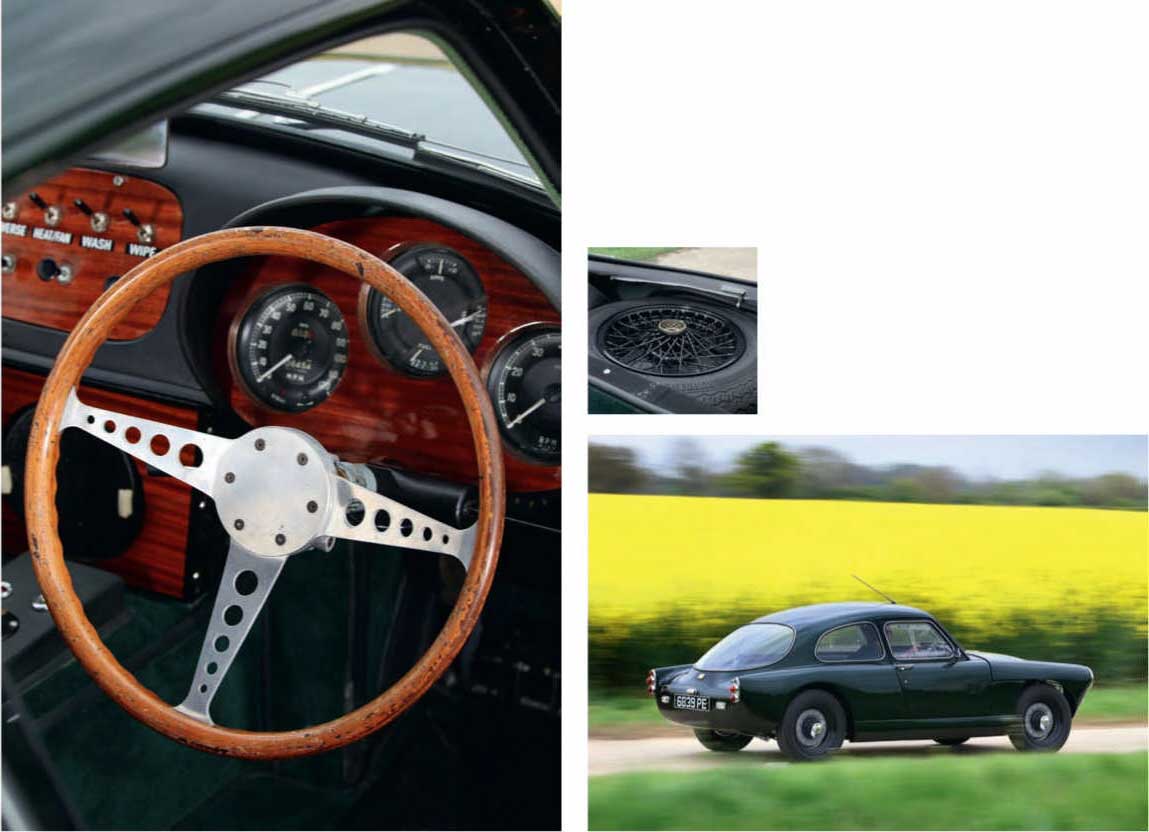
From top: Smiths clocks, with big speedometer and rev counter either side of the four-in-one gauge for temperature, oil pressure, amps and fuel behind the lovely wood-rim wheel; spare lives in the tail behind the luggage space; there’s more than a hint of Alfa Giulietta to the shape.
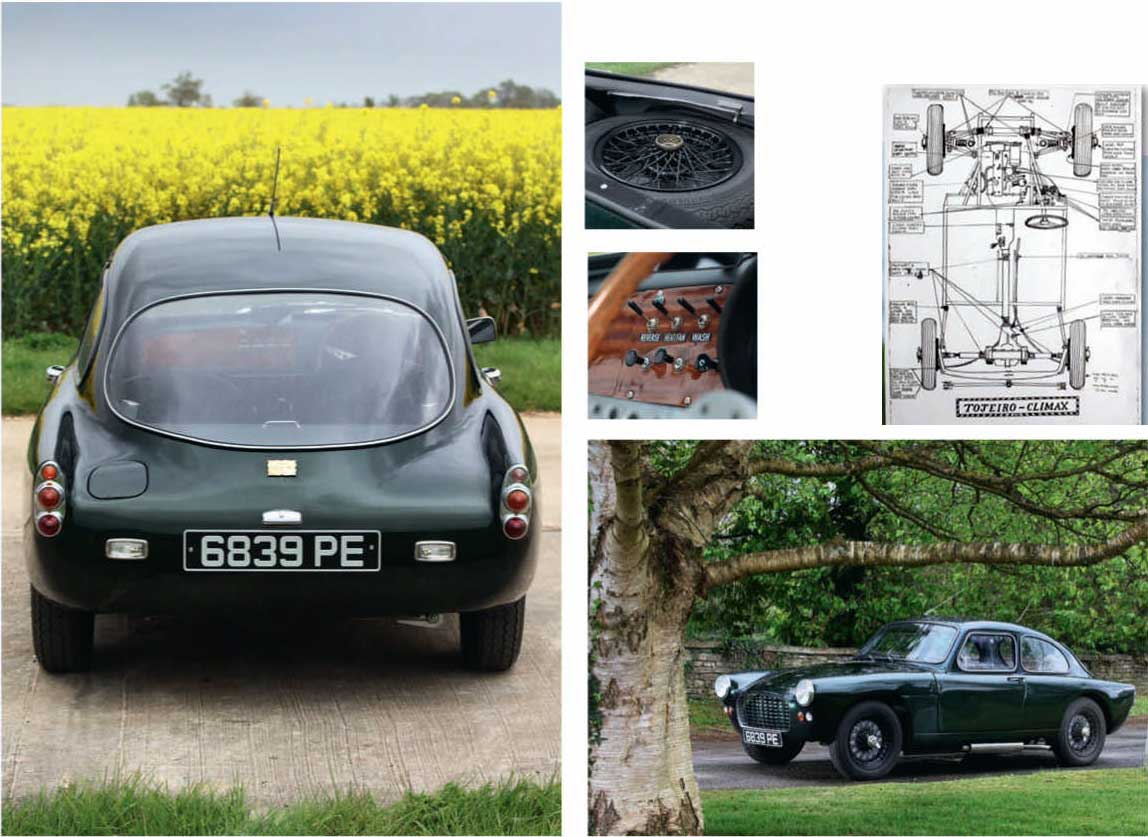
Tojeiro’s chassis genius is obvious as you exploit its deft balance on a twisty road. Inset: lubrication diagram shows wishbones at front and rear trailing arms. Below: former owner Henderson racing at Croft. It’s like a baby Greyhound, with vast rear window, yet it predates the AC; lovely set of rocker switches and buttons, with neat labels; styling – note bold side exit exhaust – could well be by Cavendish Morton, who often worked with Tojeiro, but sadly there’s no proof that it was him.
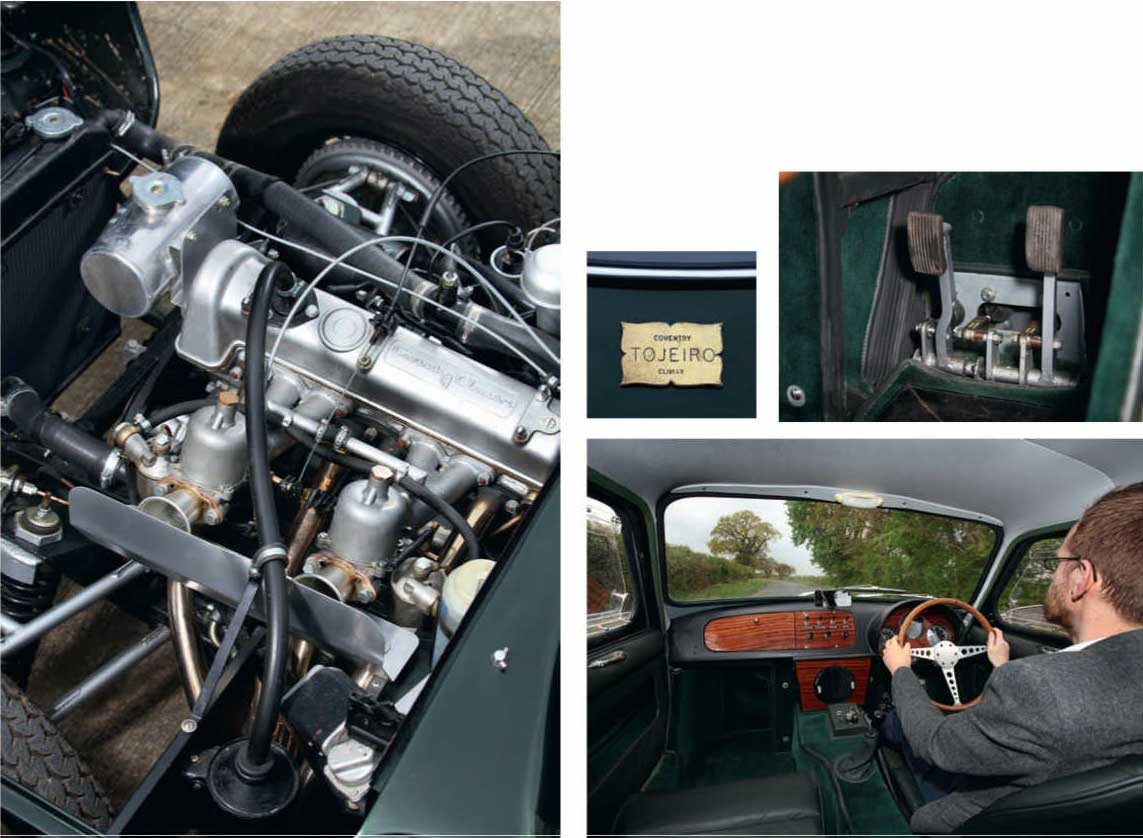
From top: famous script adorns cam cover of the gorgeous Coventry Climax motor, which is fed by twin SU carbs; plate sports both names; it feels every inch the racer but is well enough appointed to gain its GT credentials; there’s even a footrest by the exquisite little pedal-box.
John Tojeiro
Born in Estoril on 3 December 1923, to an English mother and a Portuguese father, John Tojeiro was raised in Britain. He signed up as a fitter for the Fleet Air Arm in 1942 and, intrigued by airframe construction, he set up his own light engineering business following the hostilities.
After attending the ’1946 Gransden Lodge race meeting, Tojeiro bought an MGTA that he fitted with a lightweight body. During a visit to Lister, he was inspired to design his own ladder frame, suspended by independent transverse-leaf springs. Before it was finished, he was persuaded to sell the car and became a constructor by accident. Tojeiro’s reputation was sealed in 1953 thanks to the success of the Bristol-engined LOY500, which led to his most famed creation. AC, in dire need of a new model, bought the rights to the design, the deal earning Tojeiro £5 per car for the first 100 Ace chassis.
Tojeiro also claimed to be instrumental in Rover’s adoption of the Buick V8. “I sold two engines to David Murray,” he told C&SC in 1988. “He sold one to Rover; they found it lighter than their old 3-litre unit; and the company took over the design.” Tojeiro died on 16 March 2005.

John Tojeiro
Railway arch brigade’s motor of choice
Mention the Coventry Climax fire pump to any car enthusiast worth their salt and they will most likely think of the Lotus Elite or single-seaters from the time – but that’s likely to be it. Dig deeper, and you’ll find a surprisingly wide range of low-volume cars that were fitted with variations on the FW theme.
Early incarnations of Lotus’ immortal Seven were available with FW power, as was the TVR Grantura from 1958 to the early ’60s (when larger-capacity MG units took over). Turner offered 1098cc 75bhp FWA and 1216cc 90bhp FWE units in the Turner-Climax from 1958-’1966, the engines also being an option in the fixed-head GT in the early ’60s. Welsh manufacturer Gilbern offered a Climax lump in its pretty glassfibre GT from ’1959, while Air Vice-Marshal Donald ‘Pathfinder’ Bennett’s Fairthorpe concern built 30 Climax-engined Electrons from 1956-’1965.
It would be stretching things to call the Kieft 1100 sports-racer a production car, but a derivative of The FW unit did find its way into a mass-market model. Pedants might say that the Hillman Imp’s 875cc four-pot was Climax-inspired rather than being the real deal, but in spirit at least it belongs here.

Lotus mechanics fettle Elite’s FWE at Le Mans in ’1959. Climax unit gives good performance in GRP monocoque. Assorted GTs at the first Gilbern OC concours in 1970.
Getting on track to improve the design
The vehicle most often associated with Tojeiro is the Ace, but the prolific self-taught engineer was involved with lots of other projects over the years. ‘Toj’ himself recognised the limits in torsional rigidity of the AC’s transverse-leaf ladder chassis and its Tojeiro-badged predecessors, and resisted requests to fit Jag engines for fear of the frame being unable to cope with the stresses. Instead, he developed an all-new space-frame with double wishbones and a de Dion set-up to which Lea-Francis, Jaguar and Bristol motors were fitted. Those chassis were followed in 1956 by a lighter version with a Climax FWA, plus a string of Jaguar-powered racers – largely thanks to the patronage of John Ogier, who in 1957 became a shareholder in the renamed (but still two-man) Tojeiro Car Company, and David Murray of Ecurie Ecosse.
A Formula Junior racer called the Britannia was not a success, but of more interest was a rear-mid-engined 2 ½-litre Climax-powered Le Mans racer. Two were built, and later uprated to 3.5-litre Buick and 4.7-litre (289) Ford V8s. Road cars included the stylish but expensive Zephyr-powered Britannia; just six were built.
The Cavendish Morton-styled Berkeley Bandit was a promising Anglia 105E-powered roadster that also hit trouble when its manufacturer ran out of funds. The Dax-Tojeiro Cobra replica, however, was a success that neatly bookended a career that had blossomed with the Ace, the progenitor of the iconic Anglo-American V8.
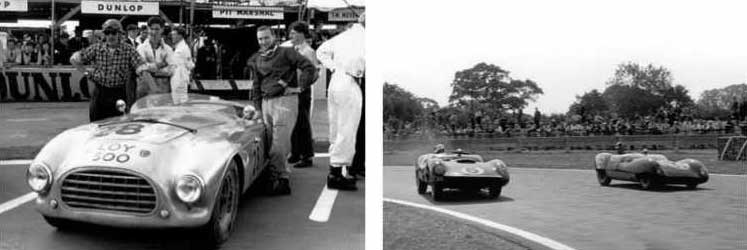
Right: Clark’s Tojeiro-Jag passes Eleven; ‘LOY 500’ of Cliff Davis, who introduced Tojeiro to Derek Hurlock.





